Electric Boats: Steyr HDS+, LTS Marine, Torqeedo, windmills & more
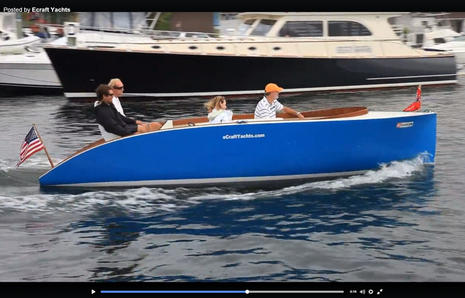 The first U.S. Electric and Hybrid Marine Expo was wonderfully educational, though I hardly knew any of the companies involved and could only understand a fraction of some seminars. On the other hand, I met a familiar fellow enthusiast before I even left the Lauderdale airport. Rufus Van Gruisen is the esteemed owner/operator of Cay Electronics, and it turns out he’s done more than just dream about quiet, efficient electric pleasure craft. That’s him in the orange cap above, showing Newport the first eCraft Yachts 20 that he helped his son to build. It looks like an excellent design to me — more detail on Facebook and in Great Lakes Scuttlebutt — and I’d presume a well-engineered power, control, and nav electronics installation.
The first U.S. Electric and Hybrid Marine Expo was wonderfully educational, though I hardly knew any of the companies involved and could only understand a fraction of some seminars. On the other hand, I met a familiar fellow enthusiast before I even left the Lauderdale airport. Rufus Van Gruisen is the esteemed owner/operator of Cay Electronics, and it turns out he’s done more than just dream about quiet, efficient electric pleasure craft. That’s him in the orange cap above, showing Newport the first eCraft Yachts 20 that he helped his son to build. It looks like an excellent design to me — more detail on Facebook and in Great Lakes Scuttlebutt — and I’d presume a well-engineered power, control, and nav electronics installation.
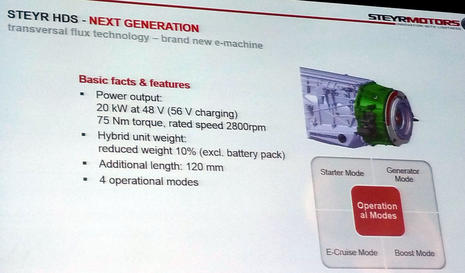 While the eCraft 20 is a pure electric dayboat that gets charged at a dock or near your garage, further roaming vessels need some sort of hybrid propulsion. The Steyr parallel Hybrid Drive System (HDS) won numerous awards when launched in 2008 and while it had some early clutch issues — apparently fixed with a redesign — this is the core technology behind the successful Greenline fleets (over 450 built). The good news (not yet online) is that a “coming soon” new HDS design will offer 20 kW of pure electric drive, a big step up from 7 kW and also applicable in boost mode with the diesel, and in generator mode.
While the eCraft 20 is a pure electric dayboat that gets charged at a dock or near your garage, further roaming vessels need some sort of hybrid propulsion. The Steyr parallel Hybrid Drive System (HDS) won numerous awards when launched in 2008 and while it had some early clutch issues — apparently fixed with a redesign — this is the core technology behind the successful Greenline fleets (over 450 built). The good news (not yet online) is that a “coming soon” new HDS design will offer 20 kW of pure electric drive, a big step up from 7 kW and also applicable in boost mode with the diesel, and in generator mode.
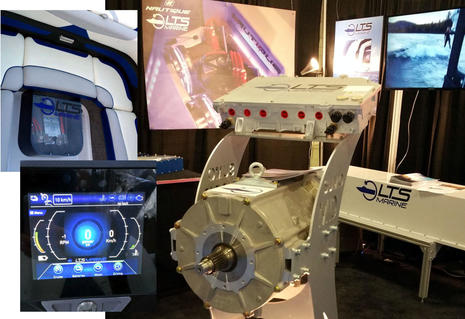 Exhibited on the show floor was a pure electric Malibu 23 LSV, which is notable when you realize that such wake boats are purposely power hungry and inefficient. LTS Marine had to power the hunky 160 kW motor above with two of those custom water-cooled Lithium battery banks to achieve a max speed of 38 mph and one hour of 20 knot “autonomy” before heading back to a charging station. And the wakeboarding owner spent an extra $170,000 not to have gas fumes messing with his or her fun. So this boat may represent an impractical extreme of electric boating, but LTS has proven that it can be done (with some gorgeous looking engineering). I did get laughing about one probably unintended consequence: The lakes where internal combustion engines are banned — and where gentle electrics like the eBoat 20 often find a home — may now learn about the wild world of waking.
Exhibited on the show floor was a pure electric Malibu 23 LSV, which is notable when you realize that such wake boats are purposely power hungry and inefficient. LTS Marine had to power the hunky 160 kW motor above with two of those custom water-cooled Lithium battery banks to achieve a max speed of 38 mph and one hour of 20 knot “autonomy” before heading back to a charging station. And the wakeboarding owner spent an extra $170,000 not to have gas fumes messing with his or her fun. So this boat may represent an impractical extreme of electric boating, but LTS has proven that it can be done (with some gorgeous looking engineering). I did get laughing about one probably unintended consequence: The lakes where internal combustion engines are banned — and where gentle electrics like the eBoat 20 often find a home — may now learn about the wild world of waking.
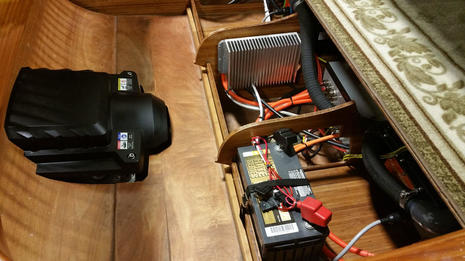 Also on display was a Symphony Conductor Six-1 “gentleman’s runabout” that can reportedly cruise at about 20 knots fully loaded (good video here). The motor, partially seen at left above, is a Torqeedo Deep Blue 80i rated at about 80 hp at its 66 kW peak input. The juice comes from a pair of Torqeedo’s big Deep Blue 80 HV Lithium batteries, which may weigh 330 pounds each but purportedly hold 12.8 kW hours of usable power at 345 volts. So why the regular 12v battery? One of the many safety features built into the whole modular Deep Blue family is a careful segregation of the very high voltage parts. In fact, you can’t use those big Lithiums until the 12v-powered monitoring system makes sure that all the HV connections and other protective sensors check out AOK.
Also on display was a Symphony Conductor Six-1 “gentleman’s runabout” that can reportedly cruise at about 20 knots fully loaded (good video here). The motor, partially seen at left above, is a Torqeedo Deep Blue 80i rated at about 80 hp at its 66 kW peak input. The juice comes from a pair of Torqeedo’s big Deep Blue 80 HV Lithium batteries, which may weigh 330 pounds each but purportedly hold 12.8 kW hours of usable power at 345 volts. So why the regular 12v battery? One of the many safety features built into the whole modular Deep Blue family is a careful segregation of the very high voltage parts. In fact, you can’t use those big Lithiums until the 12v-powered monitoring system makes sure that all the HV connections and other protective sensors check out AOK.
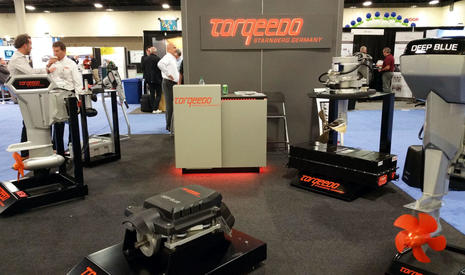 This shot of the Torqeedo booth shows the Deep Blue 80i electric inboard and the big black HV battery pack, which, by the way, comes with a 9 year warranty on 80% of its original capacity “even if you use it every day.” At left is a new and bigger Cruise outboard, and above the battery is the steerable electric saildrive that recently joined the DB Hybrid options. There’s little saildrive detail online yet, but I understand that it can be used to generate power when sailing — you select the amount of drag/amperage you want — and that a pair will also be used for easy joystick docking in the full dual drive catamaran system illustrated in this video. Torqeedo has obviously been busy, and I’m looking forward to meeting the CTO in Miami.
This shot of the Torqeedo booth shows the Deep Blue 80i electric inboard and the big black HV battery pack, which, by the way, comes with a 9 year warranty on 80% of its original capacity “even if you use it every day.” At left is a new and bigger Cruise outboard, and above the battery is the steerable electric saildrive that recently joined the DB Hybrid options. There’s little saildrive detail online yet, but I understand that it can be used to generate power when sailing — you select the amount of drag/amperage you want — and that a pair will also be used for easy joystick docking in the full dual drive catamaran system illustrated in this video. Torqeedo has obviously been busy, and I’m looking forward to meeting the CTO in Miami.
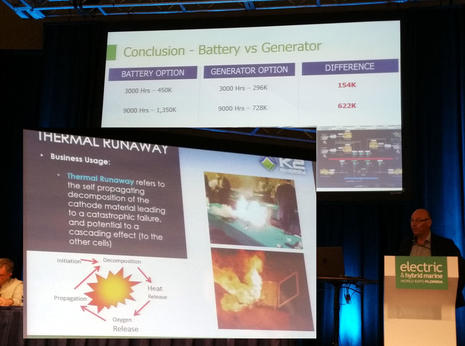 Safety is a large and understandable concern on a boat with very high voltage cables and maybe also batteries capable, say, of feeding a 160 kW motor at wide open throttle. You hear some scary stories about the damage that sort of current can inflict and several seminars also included slides like the “thermal runaway” inset above. Meanwhile the Battery vs Generator slide is describing the economic case for using a generator in a serial type hybrid system on a work boat. In fact, parallel hybrid like the Steyr HDS is often the best solution in the commercial world where a direct diesel connection to the prop(s) is most efficient under large loads. Consider, for instance, the Foss Hybrid tugs, which are now just some early examples of many commercial hybrid systems.
Safety is a large and understandable concern on a boat with very high voltage cables and maybe also batteries capable, say, of feeding a 160 kW motor at wide open throttle. You hear some scary stories about the damage that sort of current can inflict and several seminars also included slides like the “thermal runaway” inset above. Meanwhile the Battery vs Generator slide is describing the economic case for using a generator in a serial type hybrid system on a work boat. In fact, parallel hybrid like the Steyr HDS is often the best solution in the commercial world where a direct diesel connection to the prop(s) is most efficient under large loads. Consider, for instance, the Foss Hybrid tugs, which are now just some early examples of many commercial hybrid systems.
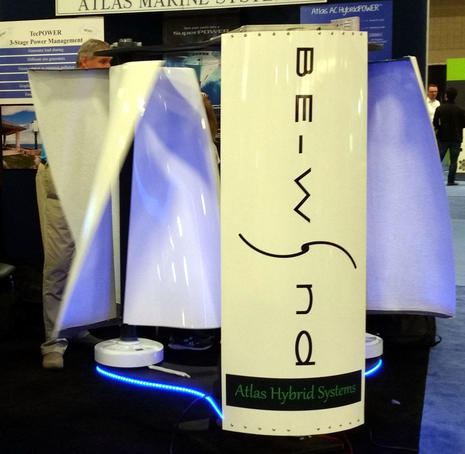 In the recreational boat world, where engine time is often a fairly small slice of the overall energy pie, more flexible serial hybrid designs like Torqeedo Deep Blue make more sense. But everyone is looking for better batteries — man, there’s a confusing subject — and also more energy efficient ways to feed them. Thus the Be-Wind vertical wind turbines being shown in the Atlas Marine Systems booth. Darned if I could find anything online about this system, but an Atlas rep told me that it can handle hurricane level winds, easily produces 1 kW as shown, and taller models can produce more. I think we’ll notice if these become popular on the megayachts Atlas works with.
In the recreational boat world, where engine time is often a fairly small slice of the overall energy pie, more flexible serial hybrid designs like Torqeedo Deep Blue make more sense. But everyone is looking for better batteries — man, there’s a confusing subject — and also more energy efficient ways to feed them. Thus the Be-Wind vertical wind turbines being shown in the Atlas Marine Systems booth. Darned if I could find anything online about this system, but an Atlas rep told me that it can handle hurricane level winds, easily produces 1 kW as shown, and taller models can produce more. I think we’ll notice if these become popular on the megayachts Atlas works with.
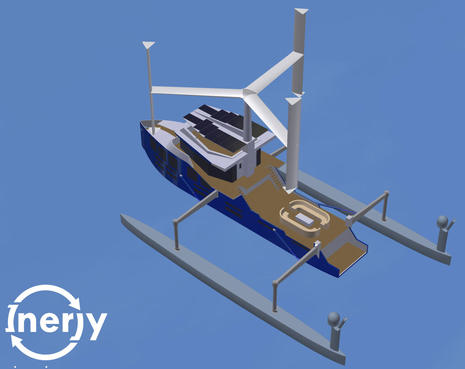 Meanwhile, the Inerjy EcoVert 75 kW Turbine makes for a much more ambitious boat project and while it hasn’t been built yet, you can contemplate the ideas behind the Gemma One design here. You’ll see that the EcoVert has many uses, but it happens that Inerjy cofounder Jamie Schlinkman is a boater and even a Panbo fan. In fact, he pointed out that they use three Maretron ultrasonic wind sensors on each turbine mast along with a CANbus control system.
Meanwhile, the Inerjy EcoVert 75 kW Turbine makes for a much more ambitious boat project and while it hasn’t been built yet, you can contemplate the ideas behind the Gemma One design here. You’ll see that the EcoVert has many uses, but it happens that Inerjy cofounder Jamie Schlinkman is a boater and even a Panbo fan. In fact, he pointed out that they use three Maretron ultrasonic wind sensors on each turbine mast along with a CANbus control system.
Schlinkman quickly acknowledged that the EcoVert vertical turbine design has a long history, but says that only now are the enabling technologies falling into place. I believe that holds true for much of what’s happening with hybrid boats, and it’s quite exciting. The Gemma One dream also reminded me of watching in awe as the esteemed local schooner captain and inventor Havilah Hawkins whomped around Penobscot Bay on his “windmill boat” back in the 80’s, sometimes dead into the wind. The power and propulsion mechanisms were entirely mechanical and possibly a bit frightening in action up close, but Capt. Hawkins certainly had the spirit, and I believe he’d enjoy at least some of what’s going on today.


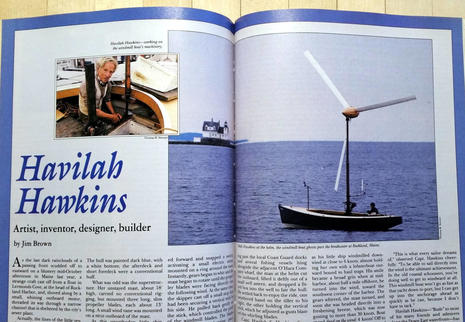
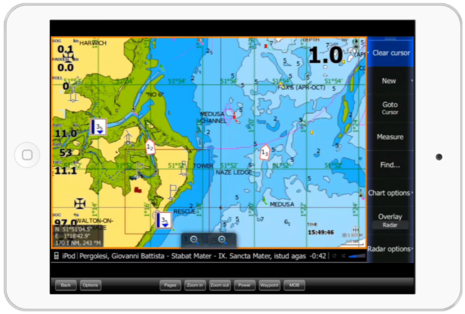
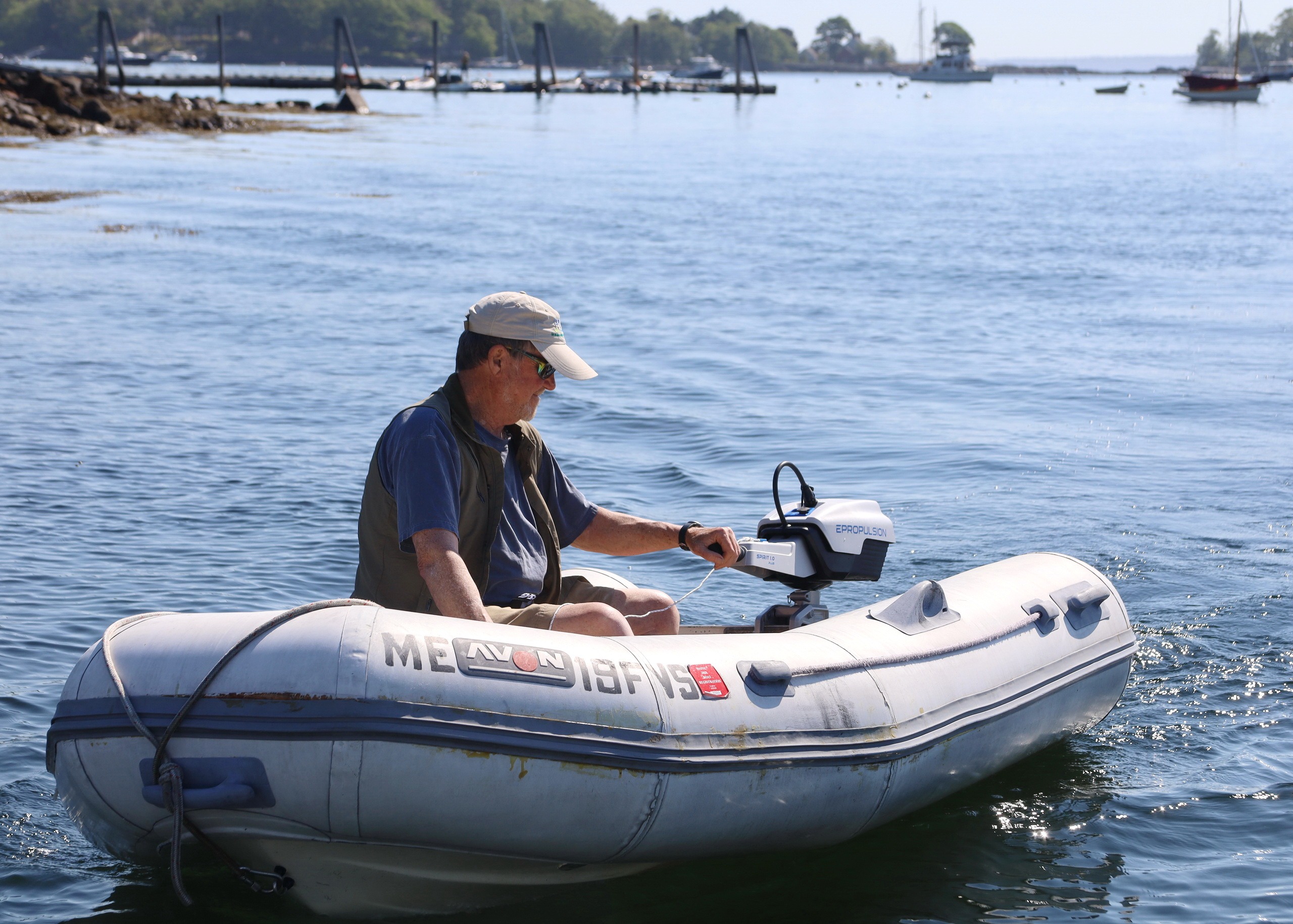
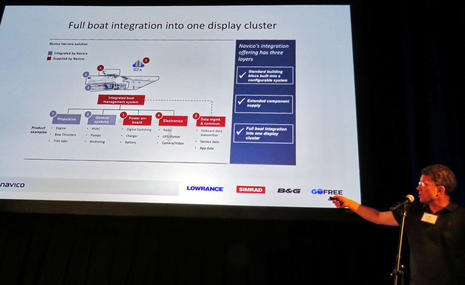








Hey Ben – I went as well and really thought the show was interesting. I spent some time talking to the folks at Pure Watercraft about their outboard motor which was also very interesting. They seem to be targeting the rowing / crew coach / quiet motor at a steady pace business.
I was however struck by the state of the battery industry. I think its still changing so fast to keep up with demand that its hard to say that batteries in 2 years will not have significantly better safety, heat control, and longevity.
Alex
If you are interested in the future of electric boats, Solar Splash is the World Championship of intercollegiate Solar/Electric boating.
http://solarsplash.com/
Thanks for covering the event Ben!
Alex, I was also struck by the state of the battery industry but maybe in a different way. There were at least 15 companies providing high energy battery systems suitable for marine applications. As for safety, there were numerous presentations that addressed safety and even the US Coast Guard had a presentation on how they will work with vessel builders to certify safety. With non-self-oxidizing chemistries like Lithium Iron Phosphate and Lithium Graphite, and also individual cell temperature monitoring, I would say the technology is pretty mature now. As for longevity, that is well understood and perfectly suitable for marine applications too. I have over 25,000 miles on my Tesla and while I have lost some peak capacity, it still works like a brand new car…and best of all needs no maintenance–something currently alien to the majority of the marine propulsion world.
A couple of interesting vessels presented at the conference: The first was presented by Leclanche and boasts a 4,300 kWh battery!:
http://e-ferryproject.eu/
This one was built and presented by Derecktor in NY:
http://www.derecktor.com/new-construction/commercial/workboats/spirit-of-the-sound/